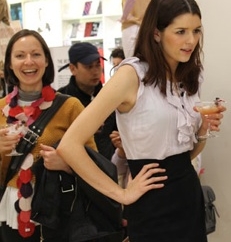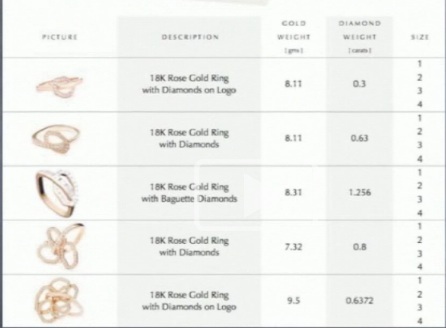Articles and News
10 Tips To Make This Your Best Trunk Show Season Yet | September 04, 2013 (0 comments)

Pelham, NY—It’s trunk show season again. Whether you host them to offer a broader selection of one of your regular brands, or as a testing ground for new designers, a successful trunk show is in everyone’s best interest.
The Jewelers’ Resource Bureau recently hosted a webinar titled, “How To Rock A Trunk Show And Close The Sale,” featuring luxury branding strategist and jewelry expert Beth Anne Bonanno of the EAB Project. The session was part of JRB’s monthly “Third Thursday At Three” webinar series focusing on selling designer jewelry.
Whether you’re a designer or retailer, new to hosting trunk shows or a seasoned pro, Bonanno’s tips will help make your event a success:
1. Be prepared! A trunk show is not the time to show up with samples for future orders; it’s about customers leaving with a wrapped box. Retailers, unless you’re comfortable with a show that’s for pre-orders only, don’t be shy about asking a new designer how much they’re ready to deliver on the spot; designers, if you’re not ready to come with a full line ready to sell at the event, think twice about approaching bigger stores until you are.
2. Have solid prices. Set prices before the event and stick to them, says Bonanno. This is not the time to adjust for gold price fluctuations; figure that out in advance when you set prices. While Bonanno doesn’t advocate leading a sale with a discount, if you are going to offer one at the event, keep it consistent across the board. This includes online: if the item is listed for one price one place and for significantly less somewhere else, it will come back on you. A discount at the counter is one thing, but a listed price is transparent to anyone who can Google.
3. Have good-quality photography with both high-resolution and low-resolution images of all pieces in the show. Retailers need the images to use for both printed mailers and online, and for their salespeople to send images to their regular clients by email or text for the show. The designer also can—and should—use social media to help the retailer make sales. “I don’t care how it gets sold, the point is to sell it,” says Bonanno.
Also have exact descriptions of the pieces, especially for higher-priced pieces with lots of gems. Cindy Edelstein, president of Jewelers’ Resource Bureau, adds, “If you don’t use your own words to describe the jewelry, people will use their own words. You need to control how it’s presented, and not leave them guessing.”
4. Have a look book. It’s a great sales tool to use at the counter, or to help salespeople in their pre-show calls to clients. It can be printed (good for the counter) and/or digital on a flash drive (good for multiple salespeople to prepare beforehand) but make sure it includes the pieces coming to the show, and has a key showing all the pieces with full descriptions and prices. Also be ready with take-away materials for consumers, whether printed or digital.

A sample price key Bonanno designed.
5. Who’s paying? Whether the jeweler offsets a portion of the designer’s travel expenses or the designer foots the entire bill, make sure it’s all in the contract before the event. Discuss everything, right down to lunch breaks, says Bonanno. She cited a designer who went an entire day without eating because it hadn’t been discussed previously and she felt awkward bringing it up on site. She now subsequently puts a lunch clause in all her trunk show contracts.
While retailers often will help share the costs—and it’s fine to ask and negotiate to have them do so—Bonanno warns designers not to expect it. Some stores won’t, and “if you can’t afford to pay your own way, you’re not ready,” she says bluntly.
6. Designers, make sure your website’s landing page has somewhere to go. Even if your own site isn’t robust, have an easy click to send users to Facebook, Pinterest, Instagram, or anywhere else that your pieces are featured. Aim for a little bit everywhere, if you can’t do deep on your own site. If you can’t focus on anything but making jewelry, find someone who can manage your social media and do it well.
“Resistance is futile,” laughs Bonanno of social media.
7. Book early. Big retailers often book fall trunk shows as early as January and February, and definitely by the Las Vegas shows in June. In Las Vegas, most events are set and trunk show conversations are focused on merchandise and details. But don’t be afraid to ask if there are any opportunities, because you never know who might cancel or what dates might not have been booked.
8. Designers, stay in touch. Big decisions like times, flights, and so forth should be already in place long before six weeks out, but retailers also have multiple shows planned and they’re not focused on all of them at once. At the six-week point, designers should touch base to discuss shipping the line, security, sending invitations, and what photos, press, and sales materials the retailers need.
9. What to bring in? When a retailer points to pieces they like, it’s a designer’s responsibility to make sure those are included at the show. Bring additional goods based on your design story, but don’t assume you know the retailer’s clientele better than the retailer. It’s a joint effort and partnership to bring something new and interesting to the client. Yes, a good salesperson will tell the person what to buy, but a good retailer also knows what their clients are likely to buy.
Discuss quantity with the retailer: Bonanno suggests 50 pieces are a good start, but fewer may be sufficient for a small show, and more may be required for a large brand in a large store.
10. It’s a joint effort at the sales counter. The store’s sales associates are the front line, but a designer has to be able to sell his or her own product—or have a representative who can. Retailers, speak up about your sales expectations, because if the designer is not comfortable selling, it may be better for you to sell the goods without him or her present. Designers and reps should never take personal or contact information from clients, says Bonanno; always direct them back to the retailer for follow-up.
So what defines trunk show success? It’s not always sales, says Bonanno. Obviously, if your sales blew through the roof, it’s a success. A first show for a new designer may not generate many—or any—sales, but if it clearly captures clients’ interest in that designer for the future, or enhances your reputation as a purveyor of the most distinctive goods, that’s also a valid measure of success. There’s also no right or wrong number of trunk shows to have, but if you’re constantly dipping into the same pool of people, you have to switch it up with different themes for different shows to keep customers interested. One jeweler, for example, opens on Sundays with football and beer for husbands—no women allowed—and it’s tremendously successful. Another hosts an annual bridal trunk show with eight or more brands present at once, and it’s almost as crowded as a rock concert, and so forth.
To hear the entire webinar—including more techniques for closing the sale—click here.
Top image: Moduspublicity.com







